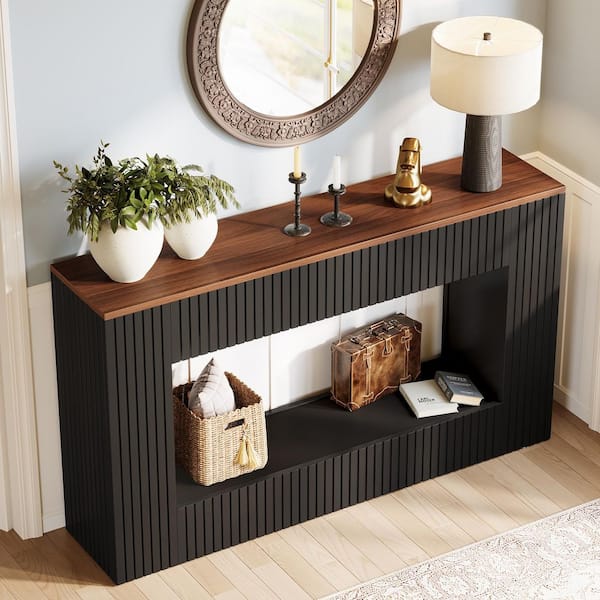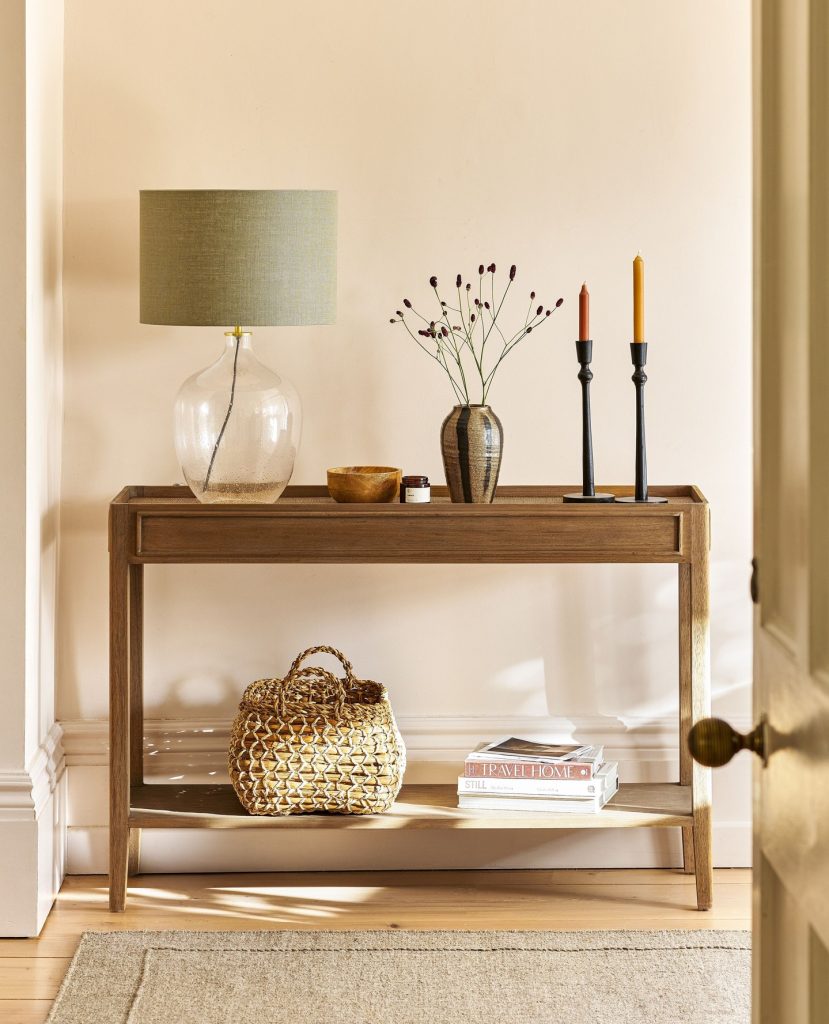Are you wondering if your entryway can fit a console table without feeling cramped? Finding the right balance between style and space can be tricky.
You want a table that adds charm and function, but you also need enough room to move comfortably. You’ll discover simple ways to measure your space and choose the perfect console table that suits your entryway. Keep reading to transform your entryway into a welcoming and stylish area without overcrowding it.
Measuring Your Entryway
Measuring your entryway carefully is the first step to deciding if a console table will fit comfortably without crowding the space. Taking precise measurements helps you avoid buying a piece that blocks movement or looks out of place. Think of it as setting the stage for a welcoming, functional area where style meets practicality.
Ideal Console Table Dimensions
Console tables usually range from 24 to 36 inches in height, which fits well with most door frames and eye levels. The width can vary, but 30 to 48 inches is common, giving you enough surface for keys, mail, or decor without overwhelming the space.
Depth is crucial: aim for 12 to 18 inches so the table doesn’t protrude too far into the walkway. If your entryway is narrow, stick closer to 12 inches to keep things feeling open and easy to navigate.
Allowing For Foot Traffic
Next, consider how people move through your entryway. You want enough room for at least 36 inches of clear walking space in front of the console table. This prevents bumping into furniture and keeps the entryway feeling spacious.
Think about your own daily routine—do you often stop to put on shoes or drop bags? If yes, you might need extra space to comfortably pause without blocking the path.
Considering Door Swing And Clearance
Don’t forget to measure the swing of doors near your entryway. A console table placed too close to a door can block it or get damaged over time. Check the distance from the door edge to the wall and ensure the table stays out of the door’s path.
Also, consider clearance for drawers or cabinet doors if your console table has storage. You want to make sure everything opens fully without hitting walls or other furniture.
Credit: www.lemon8-app.com
Choosing The Right Console Table
Choosing the right console table for your entryway is more than just picking a piece of furniture. It’s about finding the perfect balance between size, style, and function that fits your space and lifestyle. Before you buy, consider how the table will interact with your entryway’s dimensions and your daily needs.
Slim Vs. Wide Designs
Think about the width of your entryway before settling on a console table. Slim designs work best in narrow hallways or tight spaces, allowing easy movement without crowding. On the other hand, wide designs provide more surface area but need a spacious entryway to avoid feeling bulky.
Ask yourself: Do you want the table to be a subtle accent or a statement piece? If your hallway is less than 36 inches wide, a slim console around 12 inches deep is safer. For larger entryways, a wider table up to 20 inches deep can hold decorative items or keys without clutter.
Material And Style Options
Your console table’s material and style should complement your home’s overall decor. Wood offers warmth and timeless appeal, while metal or glass brings a modern, airy feel. Think about how much wear and tear the table will face; hardwood is durable, but glass needs careful handling.
Do you prefer minimalist lines or something more ornate? Rustic wood fits casual spaces, whereas sleek metal suits contemporary rooms. Matching the table to your existing furniture helps create a cohesive look, but don’t be afraid to add contrast for interest.
Storage Features To Maximize Space
Storage can turn a simple console table into a powerful organizer for your entryway. Look for options with drawers, shelves, or hooks to keep essentials like mail, gloves, and keys neatly tucked away. This reduces clutter and saves time when you’re rushing out the door.
Have you considered multi-functional pieces? Some tables include hidden compartments or baskets that blend storage with style. Even a small drawer can make a big difference in keeping your space tidy and functional.
Optimizing Small Entryways
Optimizing a small entryway can be both practical and stylish. It’s about making the most of limited space without sacrificing aesthetics. Here are some creative solutions to enhance your entryway’s functionality and charm.
Wall-mounted Console Alternatives
Wall-mounted consoles save precious floor space. They provide a sleek look while offering storage. Choose a design with shelves or hooks for added utility. This option is perfect for narrow entryways. It keeps the area tidy and organized.
Using Mirrors To Enhance Space
Mirrors create an illusion of more space. They reflect light, making small areas feel larger. Place a mirror above your console table for maximum effect. Consider a decorative frame for added style. Mirrors also help brighten up dim entryways.
Multi-functional Entryway Furniture
Furniture that serves multiple purposes is key in small spaces. Look for benches with storage under the seat. Choose tables with drawers or shelves. These pieces help keep your entryway clutter-free. They combine practicality with elegance.

Credit: www.digsdigs.com
Placement And Arrangement Tips
Figuring out the best spot for your console table in the entryway can make a huge difference in how your space feels and functions. Placement and arrangement are all about creating a welcoming vibe without crowding the area. You want to make sure the table fits naturally, supports your daily routine, and looks inviting at the same time.
Positioning For Balance And Flow
Place your console table where it doesn’t block pathways. A narrow hallway might only allow for a slim table, while a wider entryway can handle something chunkier. Think about how you move through your space—does the table help guide the flow or does it create a bumping point?
Try centering the table against the main wall or near the door, but leave enough room so doors and drawers can open freely. You want balance: the table should anchor the space without feeling like it’s crammed in.
Combining With Seating Or Hooks
Adding a bench or a small stool near your console table can provide a spot to sit while putting on shoes. Hooks or a wall-mounted rack above the table offer a place for keys, bags, or jackets, keeping things tidy and functional.
This combo saves space and adds convenience. Just make sure the seating doesn’t block access to the table and the hooks aren’t too high to reach easily. Can your entryway handle both seating and hanging storage without feeling cluttered?
Decorating Without Cluttering
Keep your console table stylish but simple. A small lamp, a bowl for loose change, or a few framed photos can personalize the space without overwhelming it. Avoid piling on too many items—empty space is your friend here.
Think about vertical decor like a tall vase or a mirror above the table to draw the eye upward and make the area feel open. What’s one meaningful item you can display that makes your entryway feel like home?
Common Space Mistakes To Avoid
Choosing the right console table for your entryway is more than just picking a stylish piece. Many make common mistakes that affect space and flow. Avoiding these errors ensures your entryway stays functional and inviting.
Overcrowding The Entryway
Putting too many items in a small space makes the area feel cramped. A bulky console table can block pathways. Leave enough room for easy movement. A clear entryway invites guests and reduces stress.
Ignoring Scale And Proportion
Console tables that are too large or too small look off balance. Match the table size to your wall and floor space. A narrow table fits better in tight spots. Choose one that complements nearby furniture and decor.
Neglecting Accessibility Needs
Think about how people use the entryway daily. Make sure the console table does not block doors or light switches. Leave space for strollers, wheelchairs, or carrying bags. Accessibility keeps the entryway practical for everyone.

Credit: www.homedepot.com
Frequently Asked Questions
How To Measure Entryway Space For A Console Table?
Measure the width and depth of your entryway. Ensure at least 2-3 feet of walking space remains. This helps avoid overcrowding while fitting a console table comfortably.
What Size Console Table Fits A Narrow Entryway?
Choose a console table 12-18 inches deep for narrow spaces. Keep the width proportional to the wall, typically under 36 inches, to maintain flow.
Can A Console Table Fit Small Entryways?
Yes, slim and narrow console tables suit small entryways well. Opt for minimalist designs to maximize space without clutter.
How Much Clearance Is Needed Around A Console Table?
Maintain at least 24-30 inches of clearance around the table. This ensures easy movement and prevents a cramped entryway feel.
Conclusion
Choosing the right console table size matters for your entryway space. Measure your area carefully before buying. A well-sized table keeps the space neat and easy to walk through. It adds style without crowding the room. Think about what you will place on the table too.
Simple planning helps you avoid clutter and makes your home welcoming. Small or large, the right console table fits your needs best. Take your time and enjoy creating a tidy, beautiful entryway.





